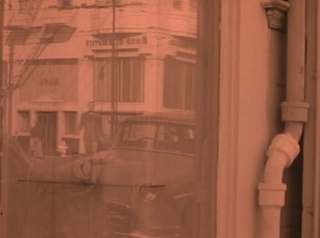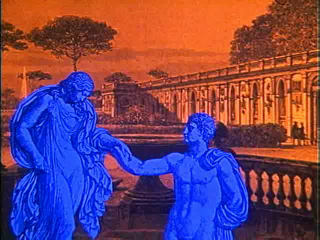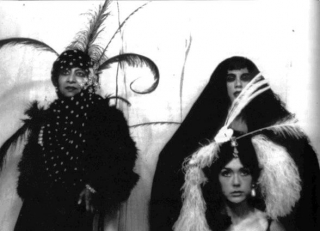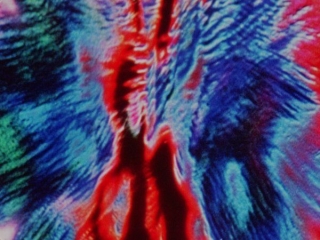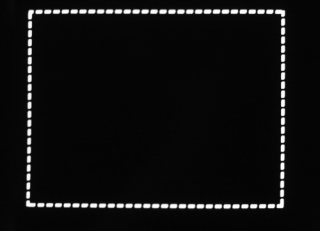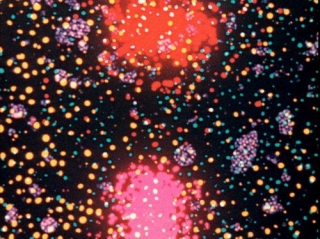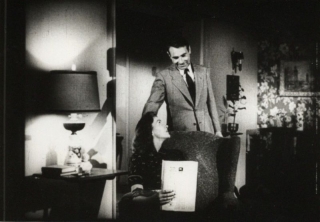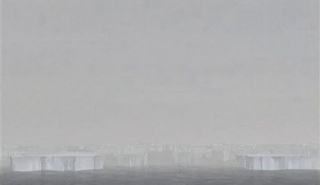Date: 4 May 2001 | Season: Larry Jordan | Tags: Oberhausen Film Festival
REAL WORLDS IMAGINED (LIVE ACTION FILMS)
Friday 4 May 2001, at 10:00pm
Oberhausen Lichtburg Filmpalast
Larry Jordan, Triptych in Four Parts, USA, 1958, 16mm, 12 min
A kaleidoscopic document of the West Coast in the beat era, and a search for spiritual adventure. 1 Portrait of artist John Reed; 2 & 3 The quest for the sacred peyote cactus; 4 The family of Wallace Berman.
Larry Jordan, Waterlight, USA, 1957, 16mm, 7 min
The transition from land to sea, and from day to night and day again. The filmmaker embarks upon a personal journey of discovery, to find out what is actually in the world and not just in his own mind.
Larry Jordan, Big Sur: The Ladies, USA, 1964, 16mm, 3 min
An impulsive cine-poem of the mostly nude ladies at the Big Sur Baths, set against the incredible California coastline. By editing entirely in-camera, the filmmaker preserves the exhuberance of the moment. A celebration of light, the sun, the joy of living.
Larry Jordan, Visions of the City, USA, 1957-79, 16mm, 9 min
The poet Michael McClure emerges from the reflected image, only to be absorbed into the hard surface of the city. A hypnotic photo essay that captures the rhythmic and melodic essence of San Francisco, 1957.
Larry Jordan, Postcard from San Miguel, USA, 1997, 16mm, 10 min
Jordan’s most recently completed film is a poetic postcard of San Miguel de Allende, set to music by Gabriel Fauré. The atmosphere of the past is evoked through the town’s colonial architecture, punctuated by lines from Lorca.
Larry Jordan, The Old House, Passing, USA, 1966, 16mm, 45 min
A young couple and their daughter spend their night in an old house and become magnetically involved with the past life of its occupants. Slow moving and dark, this ghost-film revolves around an elusive plot that has been elliptically cut by experimental editing from memory. With the drama subverted, the film develops into a representation of a mood, as the human world merges with the spirit world.
Back to top
Date: 5 May 2001 | Season: Larry Jordan | Tags: Oberhausen Film Festival
A CAVALCADE OF WONDER (ANIMATED FILMS)
Saturday 5 May 2001, at 10:00pm
Oberhausen Lichtburg Filmpalast
Larry Jordan, Our Lady of the Sphere, USA, 1969, 16mm, 10 min
A young boy’s travels through terror, death and the underworld. The flat space breaks into the illusory third dimension as the frame loses definition and threads of narrative fracture into impossible associations. True audio-visual power is conjured from the harmonic collision of ancient and modern.
Larry Jordan, Duo Concertantes, USA, 1961-64, 16mm, 9 min
1 The Centennial Exposition
2 Patricia Gives Birth to a Dream by the Doorway
A dream of pure inspiration, embracing aspects of resurrection, rebirth, ascension and the flight into higher spheres. Two separate films of nostalgia and reverie are combined into an exquisite sequence. Time is suspended as the animated engravings, liberated of meaning, transmit to the inner consciousness.
Larry Jordan, Orb, USA, 1973, 16mm, 5 min
The undefinable circle rolls through a series of transformations and possibilities. Visual modulations provide a sense of day, night and eternal space without time.
Larry Jordan, Masquerade, USA, 1981, 16mm, 5 min
Against a colourful, static background a tragic romantic scene unfolds. A man lies dying in the snow, perhaps suffering from a broken heart, the morning after a masked ball. Metamorphic figures and spirits appear, but Harlequin cannot escape death.
Larry Jordan, Minerva Looks Out Into the Zodiac, USA, 1959, 16mm, 5 min
The hard and inflexible camera eye of Minerva surveys twelve static collages. Each scene represents a hidden entrance into the underworld, imaginary landscapes existing in an illusory dimension.
Larry Jordan, Pink Swine, USA, 1963, 16mm, 3 min
Suggestive images intended to provoke hallucinatory reactions and responses in the viewer. A fast moving, rhythmic animation of junk objects and flat layouts edited entirely in-camera, accompanied by the music of The Beatles. Stroboscopic layout substitution gives the illusion of separate images seen ‘simultaneously’ but without superimposition.
Larry Jordan, Ein Traum der Liebenden (A Dream of Lovers), USA, 1964, 16mm, 7 min
White silhouette figures of man and beast perform airy feats against shifting colour backgrounds. “I wished to show new incidents in the lives of the Greek gods, not included in the mythology passed down to us. I had read all the myths and wanted there to be more.”
Larry Jordan, Finds of the Fortnight, USA, 1959-80, 16mm, 9 min
Surreal titles by Jess Collins are rapidly alternated with animated images. Using flicker-superimposition, Jordan conducts an experiment in perceptual overload. Sometimes the eye is lost in the flashing barrage of words and pictures.
Larry Jordan, The Visible Compendium, USA, 1990, 16mm, 17 min
An attempt to engage what is unknown in the mind, rather than what has been seen and known a thousand times over. “I wanted to constructed enigmas for the viewer to puzzle on and delight in.” A catalogue of visible possible experiences, which the filmmaker considers the pinnacle of his achievements as an animator.
Larry Jordan, Carabosse, USA, 1980, 16mm, 5 min
Blue figures perform a compact, jewel-like opera in surreal form on black-space. Set to the contemplative music of Erik Satie. Compounding its fragility, the film is sometimes presented on a very small scale.
Back to top
Date: 5 May 2001 | Season: Miscellaneous | Tags: Oberhausen Film Festival
THE SOMNAMBULIST’S RETREAT
Saturday 5 May 2001, at midnight
Oberhausen Festival Lounge
Peter Hutton, New York Near Sleep For Saskia, 1972, 10 min
Subtle refractions of light bring a heightened perception. We are slowly drifting away.
Steve Dwoskin, Alone, 1964, 13 min
Maybe her finger is only her finger. And no dreams live as she waits in her bed alone.
Willard Maas, Image In The Snow, 1948, 29 min
Spiritual journey through the landscape of a dream leads to a world of violence and disillusionment.
Kenneth Anger, La Lune Des Lapins, 1950-70, 14 min (long version)
The moon is a symbol of the unattainable. A lunar dream of Pierrot and the magic lantern.
Stan Vanderbeek, Newsreel of Dreams 1 & 2, 1963-64, 9 min (2 screen)
Synthetic videographic collage of history as dream events that disappear inside each other.
Paul Winkler, Chants, 1975, 15 min
A cross moves endlessly in the black void: go toward it, reach out to your own higher consciousness.
Jordan Belson, World, 1970, 6 min
Fall deeper into the ultimate meditation. A cosmic abstraction of sound and image. An inner universe.
Plus pre-recorded dream music played by Mark Webber and Gregory Kurcewicz.
Back to top
Date: 13 July 2001 | Season: Miscellaneous | Tags: Cambridge Film Festival
THE JOY OF SUBVERSION: BLONDE COBRA & NO PRESIDENT
Cambridge Arts Picturehouse
Friday 13 July 2001, at 10:30pm
Two underground archetypes, born of a deep disgust with existence, finding rapture in the rubbish dumps. Ken Jacobs and Jack Smith, doyens of the downside, were united by the gloom that saturated their everyday lives. With their shared horror of Technicolor America, they rose from the cesspool to revel in the garbage heap.
Not so much non-narrative as anti-narrative, these films constantly defeat and undermine their own success through their editing and structure. Private and social taboos are cast aside in two manic paeans to hopelessness.
Some people call it independent, experimental, avant-garde, underground, beat, trash, degenerate, incomprehensible, absurdist baloney. Some people don’t understand and some people don’t deserve to understand. Cinema of parody or cinema of paradise? Take these jewelled offerings, these fragments of true FREE CINEMA and run with it. (You might never catch up.)
Ken Jacobs & Bob Fleischner, Blonde Cobra, 1959-63, 33 min
Jack Smith, No President, 1967-70, 50 min
Screening as part of the 21st Cambridge Film Festival.
PROGRAMME NOTES
THE JOY OF SUBVERSION: BLONDE COBRA & NO PRESIDENT
Cambridge Arts Picturehouse
Friday 13 July 2001, at 10:30pm
BLONDE COBRA
Ken Jacobs & Bob Fleischner, USA, 1959-63, b/w & colour, sound, 33 min
Blonde Cobra was shot by Bob Fleischner, and abandoned after a fall-out with the leading man. The footage was recovered and reassembled (with no knowledge of the original intention) by Ken Jacobs, whose own turbulent friendship with Smith underwent a brief reconciliation for the recording of the soundtrack. Emerging from a pile of rubble in his Lower East Side apartment, Jack Smith clambers above the shit-heap of depressed, depressing, depressive post-war USA. Black humour begat black leader as he recounts, in cine-darkness, his turgid dream of Madame Nescience. A live radio muscles in on the soundtrack and the continuous sewage-flow of topical babble is beaten into obscurity.
NO PRESIDENT
Jack Smith, USA, 1967-70, b/w, sound, 50 min
In No President, Smith’s particular distaste for society is embodied in his continued indulgence in failure. A work he was unable to complete in his lifetime, its downfall was the exhaustion from overstimulation he strove to portray. We’ve been left with a bewildering construction: found footage mixed with his own phantasmagorical tableaux vivants, chaos sound jumbled with records from his eclectic collection. Presidential candidate Wendell Willkie, seen first in newsreels, then depicted by costumed creatures in grotesque set pieces, winds up auctioned on the block of a slave market. B-movie exotica tangled in delirious wonder. The collapse of order, again and again, over and out.
Back to top
Date: 13 October 2001 | Season: Cinema Auricular
CINEMA AURICULAR: CINEMA OF THE EAR
13 October – 21 October 2001
London Barbican Centre & Tate Modern
A season of film and video as part of the ELEKTRONIC festival at the Barbican.
It might seem logical to suppose a historical and natural link between electronic music and abstract or impressionistic films, but there are surprisingly few examples of films that were made in direct collaboration between filmmakers and composers or musicians. However, there is a significant body of films that ‘borrow’ or re-appropriate recordings of contemporary music, and a number of works for which their makers have assembled soundtracks which may, if separated from the visuals, be heard as extraordinary electronic compositions. In such films, electronic, tape music, noise, primitive sampling and musique concrete come together in chaos or harmony to accompany astounding visual constructions.
The film series of the Elektronic festival will present screenings in which the sound and image complement each other on the highest level. It will feature an international selection of historic and contemporary works by Bruce Conner, Malcolm Le Grice, Peter Tscherkassky and others, and a live music and film concert by Phill Niblock. Composers whose unique works may be heard of the soundtracks include Edgar Varese, Christian Fennesz, Terry Riley and Karlheinz Stockhausen.
The series will open with an informal screening in the Barbican Pit Theatre on the afternoon of Saturday 13th October. Between the films, Mark Webber and Gregory Kurcewicz will be playing recordings of rare and wonderful electronic music. Come down to our level and see what you’re in for.
Date: 13 October 2001 | Season: Cinema Auricular
OF SYNTHESIS AND SYNTHETICS
Saturday 13 October 2001, at 3:00pm
London Barbican Pit Theatre
Sounds emanating from the early electro-acoustic studios and the primitive/pioneering synthesisers of Robert Moog and Don Buchla. An informal film screening punctuated by recordings of scarce and wonderful electronic music through the ages played by Mark Webber and Gregory Kurcewicz. Including Mick Jagger’s mind-bending score for Kenneth Anger’s Invocation of My Demon Brother and rare recordings of Varese and Ussachevsky. Come hang out, watch films, listen to music, drink coffee, pretend to stroke your beard (though that’s an entirely inappropriate thing to do).
Note: Where the soundtrack is not by the filmmaker, the composer’s name is in square brackets
William Pye, Reflections, UK, 1972, colour, sound, 17 min
David Ringo, Balconies One, USA, c.1968, b/w, sound, 6 min [Edgar Varese]
Ian Hugo, Aphrodisiac I, USA, 1971, colour, sound, 6 min [David Horowicz]
Adam Beckett, Heavy-Light, USA, 1973, colour, sound, 7 min [Barry Schrader]
Hollis Frampton, Special Effects (Hapax Legomena VII), USA, 1972, b/w, sound, 11 min [Don Buchla & Victor Grauer]
Lloyd Williams, Two Images For A Computer Piece (With Interlude), USA, 1970, b/w, sound, 10 min [Vladimir Ussachevsky]
Ed Emshwiller, Thermogenesis, USA, 1972, colour, sound, 12 min [Robert Moog & Jeff Slotnik]
Tom De Witt, AtmosFear, USA, 1966, colour, sound, 6 min
Kenneth Anger, Invocation Of My Demon Brother, USA, 1969, colour, sound, 11 min [Mick Jagger]
Norman McLaren, Synchromy, Canada, 1971, colour, sound, 7 min
David Rimmer, Migration, Canada, 1969, colour, sound, 12m [Phil Werren]
Date: 14 October 2001 | Season: Cinema Auricular
PHILL NIBLOCK LIVE PERFORMANCE
Sunday 14 October 2001, at 6:15pm
London Barbican Pit Theatre
Intermedia artist Phill Niblock (USA) presents a concert of live and pre-recorded microtonal music with simultaneous triple video projection of sections from his long running Movement of People Working film series, shot in Mexico, Peru, Brasil, and China. Niblock makes thick, loud drones of music, filled with microtones of instrumental timbres that generate a multitude of difference tones in the performance space.
Phill Niblock, Hurdy Hurry (for Hurdy Gurdy)
Phill Niblock, A Y U Live (aka As Yet Untitled) (for Baritone Voice)
Phill Niblock, Guitar Too, For Four (for Electric Guitar)
Phill Niblock, Pan Fried 25 (for Bowed Piano)
Guitar Too, For Four will be augmented by a live electric guitar quartet featuring Jem Finer, Robert P. Lee, Matt Rogalsky and Mark Webber.
Date: 15 October 2001 | Season: Cinema Auricular
TRANSCENDENT POWER: ELECTRONIC ELEVATION AND SYSTEM STIMULATION
Monday 15 October 2001, at 7:30pm
London Barbican Cinema
Going beyond direct experience into the spiritual and ecstatic realms, reaching outwards / inwards / upwards toward perception. Beginning with a film that “plays directly on the mind through programatic stimulation of the central nervous system” and ending with Bruce Conner’s amazing hallucinogenic journey. Rarely seen works by the abstract masters Davis and Belson, plus Kirchhofer’s stunning dematerialization of celluloid and Vegter’s captivating computer piece.
Note: Where the soundtrack is not by the filmmaker, the composer’s name is in square brackets
Standish Lawder, Raindance, 1972, 16 min [Robert Withers]
James Whitney, Yantra, 1950-57, 8 min [Henk Badings]
James Davis, Energies, 1957, 10 min [Norman De Marco]
Patrice Kirchhofer, Densité Optique 1, 1977, 27 min
Daina Krumins, The Divine Miracle, 1973, 5 min [Rhys Chatham]
Bart Vegter, Nacht Licht, 1993, 13 min [Kees van der Knaap]
Jordan Belson, Allures, 1961, 7 min
Bruce Conner, Looking For Mushrooms, 1961/96, 15 min [Terry Riley]
PROGRAMME NOTES
TRANSCENDENT POWER: ELECTRONIC ELEVATION AND SYSTEM STIMULATION
Monday 15 October 2001, at 7:30pm
London Barbican Cinema
RAINDANCE
Standish Lawder, USA, 1972, colour, sound, 16 min [Robert Withers]
Plays directly on the mind through programatic simulation of the central nervous system. Individual frames of film are imprinted on the retina of the eye in a rhythm, sequence and intensity that corresponds to Apha-Wave frequencies of the brain. Becomes an experience of meditative liberation beyond the threshold of visual comprehension. Visions turn inward. The film directs our mental processes, controlling how we think as well as what we see. Images fuse with their after-images, colours arise from retinal release of exhausted nerve endings, forms dance across short-circuited synapses of the mind. Made entirely from a scrap of found footage taken from an old animated cartoon representing a sheet of falling rain. The cartoon was called The History of Cinema.
YANTRA
James Whitney, USA, 1950-57, colour, sound, 8 min [Henk Badings]
The repeated accelerating flickers between black and white or solid colour frames photo-kinetically induce an ‘alpha’ meditative state. Into the climax of these generative alternations of spectral opposites, the dots enter and enact movements which are carefully ‘choreographed’ in the sense of purely visual ‘music’. The screen is scrupulously sustained as a flat expository surface, and a reflexive consciousness of the film material process is maintained by the use of flickers, transparent / white backgrounds, scratches, and solarized, step-printed episodes, in which the hand-wrought, irregular textures also recall James’ expertise as a raku potter and the alchemical processes of transmuting elements, in this case the coloured chemicals of the film emulsion by the ‘solar’ fire. (William Moritz)
ENERGIES
James Davis, USA 1957, colour, sound, 10 min [Norman De Marco]
Just as the musician organises rhythms of sound in order to stimulate imagination and produce an emotional response, so I organise visual rhythms of moving forms of colour. Also like the musician, who doesn’t use the sounds of nature but invented sounds, produced by various instruments, I use invented forms of colour which I produce artificially with brightly coloured transparent plastics. I set them in motion, play light upon them, and film what happens. Obviously, I am not trying to present facts or to tell a story. I am trying to stir the creative imagination of my fellow men.
DENSITÉ OPTIQUE 1
Patrice Kirchhofer, France, 1977, colour, sound, 27 min
This film is an abyss. Abyssus abyssum invocat. A film made of other films. It is deja vu. ‘Déjà vu’ is a general impression of the work. A somewhat melancholic ‘déjà vu’. Adolescence also. A slow rhythm, jerked like a wave, the film makes progress underneath the eyes. Under which eyes? Those of the slow anguish of adolescence. Which one doesn’t resolve, sometimes…
THE DIVINE MIRACLE
Daina Krumins, USA, 1973, colour, sound, 5 min [Rhys Chatham]
An intriguing composite of what looks like animation and pageant-like live action is The Divine Miracle, which treads a delicate line between reverence and spoof as it briefly portrays the agony, death and ascension of Christ in the vividly coloured and heavily outlined style of Catholic devotional postcards, while tiny angels (consisting only of heads and wings) circle like slow mosquitoes about the central figure. Ms. Krumins tells me that no animation is involved, that the entire action was filmed in a studio, and that Christ, the angels and the background were combined in the printing. She also says it took her two years to produce it. (Edgar Daniels)
NACHT LICHT
Bart Vegter, Netherlands, 1993, colour, sound, 13 min [Kees van der Knaap]
A computer-film in three parts. The images consist of 8 to 14 independent elements. Each part has its own, formal starting-point. On this formal basis, variations are executed by gradual changes in position, direction, movement, velocity and colour of the elements. After making four animated abstract films ‘by hand’, this is my first film made with a computer. The formal approach that I use generally in making films proved to be very suitable for the way a computer works and can be programmed. This brought me to writing image- generating programs in computer-language, of which Nacht-Licht is the first result as film. The way I make films can be compared to building a “machine” which produces images. This machine consists of the working-principle: the system I choose to generate the images. In this manner series of images are generated, determined by (1) the machine, and (2) the data I put into it.
ALLURES
Jordan Belson, USA, 1961, colour, sound, 7 min
I think of Allures as a combination of molecular structures and astronomical events mixed with subconscious and subjective phenomena – all happening simultaneously. The beginning is almost purely sensual, the end perhaps totally nonmaterial. It seems to move from matter to spirit in some way. Oskar Fischinger had been experimenting with spatial dimensions, but Allures seemed to be outer space rather than earth space. After working with some very sophisticated equipment in the Vortex Concerts, I learned the effectiveness of something as simple as fading in and out very slowly.
LOOKING FOR MUSHROOMS
Bruce Conner, USA, 1961/96, colour, sound, 15 min [Terry Riley]
Looking For Mushrooms unfolds at one and the same time as a hyperactive, realistic recording – a travel diary – and as a freewheeling, almost hallucinatory spectacle. The arc of the film’s structure suggests a shift from the material world shown in great detail to a purely ideational realm of art. What reconciles these seemingly contradictory zones is Conner’s mediating sensibility … In 1995, Conner revised Looking For Mushrooms, [which was] step-printed and slowed down by a factor of five, and given a new score. The film gained a heightened level of visibility through a pacing that restrained the abstracting speed of the original shooting, cutting, and superimposition; and it acquired a potent acoustic counterpoint through the addition of a performance by Terry Riley that highlights the microrhythms of Conner’s masterful camera work and complex montage. (Bruce Jenkins)
Back to top
Date: 16 October 2001 | Season: Cinema Auricular
CURRENTS OF CHAOS: ELECTRO-SHOCK CINEMA
Tuesday 16 October 2001, at 6:15pm
London Barbican Cinema
Confusion … delusion … retribution. Electronic feel flows as your nervous system careens into overdrive. From the chaotic Outer Space to the sublime #11, five films plugged directly into the National Grid to give maximum audio-visual pleasure (or pain). Throbbing, shouting, screaming, smashing … This is not for the faint-hearted, but what doesn’t kill you makes you stronger.
Note: Where the soundtrack is not by the filmmaker, the composer’s name is in square brackets
Peter Tscherkassky, Outer Space, 1999, 10 min
Hollis Frampton, Critical Mass, 1971, 25 min
Martin Arnold, pièce touchée, 1989, 15 min
Paul Sharits, Axiomatic Granularity, 1972-73, 20 min
Joost Rekveld, #11 (Marey<->Moiré), 1999, 21 min [Edwin van der Heide]
PROGRAMME NOTES
CURRENTS OF CHAOS: ELECTRO-SHOCK CINEMA
Tuesday 16 October 2001, at 6:15pm
London Barbican Cinema
OUTER SPACE
Peter Tscherkassky, Austria, 1999, b/w, sound, 10 min
A woman, terrorised by an invisible and aggressive force, is also exposed to the audience’s gaze, a prisoner in two senses. Outer Space agitates this construction, which is prototypical for gender hierarchies and classic cinema’s viewing regime, and allows the protagonist to turn them upside down. Flickering images, everything crashes, explodes; perforations and the soundtrack are engaged in a violent struggle. The story ends in the woman’s resistant gaze. (Isabella Reicher)
CRITICAL MASS
Hollis Frampton, Critical Mass, USA, 1971, b/w, sound, 25 min
As a work of art I think Critical Mass is quite universal and deals with all quarrels (those between men and women, or men and men, or women and women, or children, or war). It is war!…It is one of the most delicate and clear statements of inter-human relationships and the difficulties of them that I have ever seen. It is very funny, and rather obviously so. It is a magic film in that you can enjoy it, with greater and greater appreciation, each time you look at it. Most aesthetic experiences are not enjoyable on the surface. You have to look at them a number of times before you are able to fully enjoy them, but this one stands up at once, and again and again, and is amazingly clear. (Stan Brakhage)
pièce touchée
Martin Arnold, Austria, 1989, b/w, sound, 15 min
While Muybridge seems to have believed his photographs analysed the motion of ‘reality’ Arnold is well aware that piéce touchée explores a Hollywood cliché that is, at most, only a pretence of reality: a cinematic gesture that polemicises a culturally approved relationship between the genders. Arnold uses his optical printer to lay bare the gender-political implications of the husband’s arrival and to transform this gesture, which has become nearly invisible to most viewers, into a phantasmagoria of visual effects that would make any trick-film director proud. (Scott MacDonald)
AXIOMATIC GRANULARITY
Paul Sharits, USA, 1972-73, colour, sound, 20 min
In Spring 1972 a series of analyses of colour emulsion ‘grain’ imagery was undertaken (the word ‘imagery: is significant because only representations of light sensitive crystals, or ‘grain’, remain on a developed roll of colour film). The investigation is preliminary to the shooting of Section 1 of “Re: Re: Projection”, Variable Emulsion Density, wherein attempts to construct convincing lap dissolves of solid colour fields with straight fine grain Ektachrome ECO proved unsatisfactory. It was thought that more ‘grainy’ colour field interactions might adequately prevent the undesirable smoothness of hue mixture resulting from ECO superimposition. A discreteness of individual hues, during superimposition, is necessary; then, a switch to Ektachrome EF, pushed extra stops in development, seemed somewhat reasonable. Still, unexpected (colour blurring) problems arose and it was clear that a ‘blow up’ of the situation was called for; a set of primary principles was needed and, particle by particle, Axiomatic Granularity seemed to formulate itself. Its ‘structure’ lacks normative ‘expressive intentionality’.
#11 (MAREY<->MOIRÉ)
Joost Rekveld, Netherlands, 1999, colour, sound, 21 min [Edwin van der Heide]
A film in which all images were generated by intermittently recording the movement of a line. It is a film about the discontinuity that lies at the heart of the film medium. After making films #3 and #5 I was thinking about other methods to generate images by distributing light across film frames in perverted ways. One idea that came to mind was to record a continuous movement with long exposures like I had been doing before, but to interrupt these exposures many times to generate visual patterns. This would create interesting interferences between the motions involved. The other development was my increasing interest in the technological history of film. I had been looking for a kind of ‘pure’ film: images the film apparatus would come up with if left alone, as it were. While thinking about ‘pure’ film I started to look towards the historic origins of film and new media in general. Besides “#11” this led to experiments I did with various mechanical installations using nipkow discs or anorthoscopes. In order to make the film I constructed a machine with the help of which I was able control three movements: the movement of the film in the camera , the rotation of a shutter in front of the lightsource, and the movement of a line in front of the camera. The interferences possible between these three motions are the material I used to compose #11. For every section of the film I recorded a set of high contrast black and white originals which I used in the optical printer to create interference images in colour.
Back to top
Date: 17 October 2001 | Season: Cinema Auricular
NEW AGE VOLTAGE: CONTEMPORARY DIGITAL SOUND AND VISION
Wednesday 17 October 2001, at 6:00pm
London Barbican Prompt Corner
The sounds of the analogue versus the digital, burning a cathode ray hole direct through your retina. A video programme of recent audio-visions from Vienna and other painfully modern assemblages from UK, France and Canada. Having broken sound and image down to its constituent blips and pixels, these contemporary filmmakers are reconstructing matter in beguiling new ways.
Note: Where the soundtrack is not by the filmmaker, the composer’s name is in square brackets
Billy Roisz & Dieter Kovacic, smokfraqs, 2001, 4 min
Steven Ball, Sevenths Synthesis, 2001, 7 min
Myriam Bessette, Azur, 2001, 3 min
Jurgen Moritz, Instrument, 1997, 5 min [Christian Fennesz]
Ben Pointeker, Overfart, 1999, 6 min [General Magic]
Nicolas Berthelot, Chrominances, 2000, 6 min
ReMI, comp.tot4: Zarakesh, 1999, 10 min [Renata Oblak]
[n:ja], track 09, 2001, 4 min [Shabotinski]
Herwig Weiser, Entrée, 1999, 9 min
Michaela Schwentner, Transistor, 2000, 6 min [Radian]
Karoe Goldt, ILOX, 2001, 3 min [Rashim]
PROGRAMME NOTES
NEW AGE VOLTAGE: CONTEMPORARY DIGITAL SOUND AND VISION
Wednesday 17 October 2001, at 6:00pm
London Barbican Prompt Corner
smokfraqs
Billy Roisz & Dieter Kovacic, Austria, 2001, colour, sound, 4 min
Distorted geometric forms are used to create a type of grainy texture, or a flickering background of subdued coloration in front of which white particles dance. Frames are repeated into infinity and a drop meanders across the finely grained strip. Eight 30-second sequences punctuated by black frames: smokfraqs, a serial work, is made compelling in part by its structural clarity and formal simplicity. (Isabella Reicher)
SEVENTHS SYNTHESIS
Steven Ball, UK, 2001, colour, sound, 7 min
Animated abstracted synthetic sound-to-image/image-to-sound digital material parsing experiments collide with trad pagan Beltane folk dance remixed Seven Step Polka in fragmentary, fractured fast digital scratch mix.
AZUR
Myriam Bessette, Canada, 2001, colour, sound, 3 min
Composed of synthetic light and voice samples, Azur attempts to establish an emotional link with the spectator.
INSTRUMENT
Jurgen Moritz, Austria, 1997, colour, sound, 5 min [Christian Fennesz]
Instrument is reminiscent of found footage shot a long time ago: six seconds of a girl moving. Moritz calls it ‘six seconds of innocence’. He manipulated the material until only fragments of this innocence remained. To the pumping rhythmn of the music the girl is simultaneously present and absent, never totally present. Moritz makes her intangible and thus creates space for ones own fantasy. (Lies Holtrop)
OVERFART
Ben Pointeker, Austria, 1999, colour, sound, 6 min [General Magic]
Inspired by the filmmaker’s interest in early Romantic landscape painting, especially the works of Caspar David Friedrich. Though “Temko” by General Magic is virtually the sole element of the soundtrack, this work was not intended to be a music video. The abstract spatiality of the music, which was apparently set in contrast to the images, and their cycles complement one another to produce the same intangibility.
CHROMINANCES
Nicolas Berthelot, France, 2000, colour, sound, 6 min
I believe that each image is creative of music and that each sound is a creator of images, and the two entities are independent of each other. Chrominances is built like a conversation between visual and musical reasoning. A new dialogue is born, a dialogue which neither visual, nor aural. It is a dialogue which binds the audio-visual spectator with the object, a dialogue which is not imposed, an original dialogue on each vision, each hearing. I tried to make a creative film of freedom, where the eyes and the ears would be two dancers who always dance together for the first time.
comp.tot4: ZARAKESH
ReMI, Austria, 1999, colour, sound, 10 min [Renata Oblak]
During a transmission, a video recording was damaged by defective equipment to the extent that none of the original concrete elements were visible. The fragments remaining from the process of decomposition were fed into a defective computer system, and a camera was able to capture only a portion of the stream of information. The result: the originally concrete footage was reorganised in a different aesthetic context through these limitations.
track 09
[n:ja], Austria, 2001, colour, sound, 4 min [Shabotinski]
A lively game with spatial structures. The constant modulation of scales and the resulting shifts in the grid’s spaces provide glimpses into ‘microscopic’ spaces.
ENTRÉE
Herwig Weiser, Austria, 1999, b/w, sound, 9 min
A reflection on the fusion of viewer and visual world in hi-tech cinema locations. The raw stock of the videotape is grainy film footage shot in the Parc d’image in Poitiers: the spherical crystalloid monumental architecture on green fields, oversize screens and dark arenas reserved for audiences. Multiple visual echoes, double images and the industrial staccato of sound samples on the soundtrack represent the technical subsumation of people subjected to the dictate of a robot-controlled event that consigns the viewers, unconsciously, from one experimental world to the next, and causes them ultimately to vanish in the process. (Reinhard Wolf)
TRANSISTOR
Michaela Schwentner, Austria, 2000, colour, sound, 6 min [Radian]
Accompanied by short, choppy segments of noise fragments, geometric gridworks appear with equal abruptness, as in a visual staccato. This not only places a visual matrix underneath the rasping, eruptive sound as a foundation, it also reveals the underlying matrix-like quality, the locking function in the digital culture as the interface at which graphic and acoustic elements have always overlapped. (Christian Höller)
ILOX
Karoe Goldt, 2001, Austria, colour, sound, 3 min [Rashim]
In a barely noticeable way, vertical strips with shades of red move intermittently to the rhythmically snapping and crackling soundtrack by Rashim (Yasmina Haddad and Gina Hell). The vague shadow of a twig appears through the strips of colour. The work uses this radical reduction to create an enormous amount of tension. To achieve this result, Karo Goldt animated over two thousand digitally manipulated photographs of a red, leafless plant called ilox. The influence of Colour Field painters such as Mark Rothko and Ad Reinhardt on the filmmaker is obvious, whose work in this medium followed her involvement with painting and photography. (Norbert Pfaffenbichler)
Back to top
